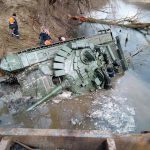
Thoughts on ecology and russian corpses

I never thought I’d have to raise this topic, but we promised not to write directly about combat operations so as not to give the enemy even a scrap of information useful for analysis. That doesn’t mean we have no information at all — it only means we have to shift the emphasis a little to other war-related topics, for example the economy and now, ecology. No, I’m not talking about global warming or about some iceberg breaking off Antarctica with penguins on it that. The real problem is different: the growing issue of russian corpses and their ecological consequences. It is fundamental, and it grows daily at a frightening pace. Something must be done.
Patrols and Bandits
Everyone knows that in many settlements of Ukraine there are joint patrols of police, territorial defence and local gangs who temporarily left their usual business and decided that right now it’s important to wipe out all the scum that come with matryoshkas and balalaikas. In other places the bandits, seeing how poorly armed the territorial defence is, share weapons with the TRO (Ukrainian territorial defence). And in general, if Moscow already knows about this, they should be packing up and leaving Ukraine — not just abroad, but beyond the Urals.
Meanwhile, ecology gets no attention. We usually think of it only when noticing colourful clips on stray dogs’ ears — marks that vets once vaccinated them. But now? Forgotten. And that’s unfair, because the problem grows. Ukraine loses people — soldiers and civilians. The occupiers shell residential areas. Lately, no one doubts: this is not accident but deliberate murder.
We won’t debate The Hague now — it has already filed statements and opened investigations into russian war crimes, which will undoubtedly turn into a new Nuremberg — but we will simply note that we collect the bodies of the dead and, by accepted custom, bury them, because these are our people. With the occupiers it’s different. They collect their dead only where they can and where they can find them at all, and that happens in less than half of the cases. I think the total number of “two-hundreds” (dead) today will surpass 10,000, and to even haul all that corpse-cargo to Belarus or Crimea you’d need convoys of trucks that nobody has seen. That means only a tiny fraction of occupiers’ corpses have been evacuated from Ukraine — so where are the rest?
Russian Landings and Hunts
After all, the enemy tried several times to carry out parachute and helicopter landings. As is known, they all ended the same way. They smashed a lot of themselves along with helicopters and planes, and in that case there’s a wholesale supply of russian corpses. Only part of their “special forces” — and it is indeed spetsnaz that lands that way — scatter into the forests, where both National Guard fighters and local hunters shoot them down. For those hunters, an unexpected hunting season for the “russian camouflaged deer” has opened. No one really knows or wants to know how many of them fell there, because, unlike a boar or roe deer taken by hunters, that trophy is completely useless — the important thing is that it lies still and is quiet.
We want to make it clear again: ordinary troops never parachute from planes or helicopters. That’s done either by paratroopers or by special forces fighters trained both for landing and for operations after landing. In other words, we are talking about the elite of the elite, and those “russian-deer” are the real special catches that are already running out for the russians. Yes, others may be moved by planes, but only between base airfields, without parachute drops.
And so their vaunted spetsnaz meet hunters who simply cut them down, choosing spots with at least a crooked little birch nearby — symbolic, you know. After that practically none of those highly trained and hyped “warriors” make it home.
Safari, Trophies, and Russian Corpses
The biggest hunts happened near Vasylkiv, Brody, and the “Hadyach Safari.” There it was not spetsnaz, but a strike column. Hunters even came from Poltava not to miss the season. The trophies in such hunts? Equipment. The carcasses — useless. They remain where they fall. And here the ecological issue begins.
In the wild there are scavenger animals that handle this task quickly and cleanly. Those animals are equipped for it: evolution has honed them for that niche in the food chain. In towns, In towns, stray dogs replace them.
Earlier, dogs ate scraps from restaurants and shops. Now restaurants close. Shops barely function. The menu of dogs changes. In battle zones, “russian venison” lies everywhere. Constant shelling prevents collection of corpses. So stray dogs dispose of the “special forces” themselves.
What happens to animals after such a diet? Nobody knows. If russian TV can turn a human brain into a bucket of filth, imagine what russian corpses do to dogs. Eco-lovers have reason to worry. One logical solution appears: let this process unfold in russia itself. If they can’t live without killing, let them do it at home. There they will bury their own dead, and their own dogs will adapt to the new ration.
Related posts:
